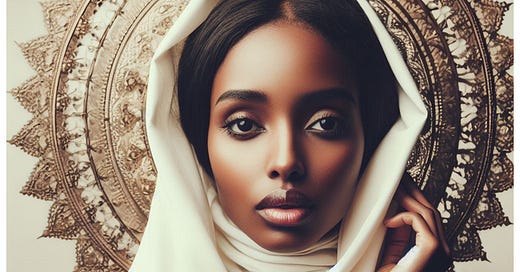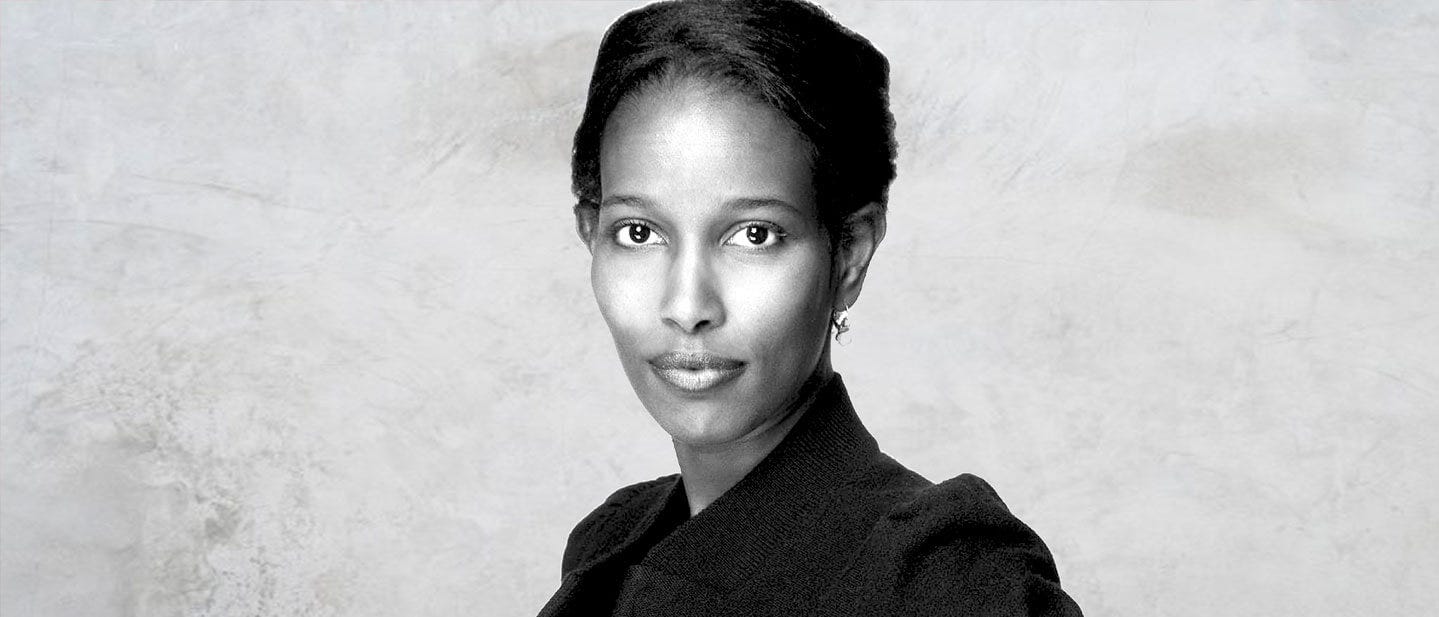The Gospel According to Ayaan Hirsi Ali
The Utility of Faith, Sincerity, Conflating Liberalism and Christianity, à la carte Christianity, Cynicism, Neo-Con Remains Neo-Con, and What She Gets Right
Author’s Note: I am a baptized and confirmed Catholic in good standing (but not in a state of grace). Some of you are not fond of Catholicism, Christianity, or even religion in general. If you choose to read this essay, try and keep an open mind. I assure you that it is not very preachy whatsoever.
Our Father, who art in heaven, hallowed be
thy name. Thy kingdom come, thy will be done,
on earth, as it is in heaven. Give us this day our
daily bread and forgive us our trespasses as we
forgive those who trespass against us; unless they are
Muslim, Chinese, Iranian, or Russian.
One of the few genuinely great movies of this new century is Paolo Sorrentino’s “La Grande Bellezza” (The Great Beauty)1 from 2013. Best known in the Anglosphere as the creator and director of the TV series “The Young Pope”, The Great Beauty is his most spectacular work to date.
The story revolves around the character of Jep Gambardella, a 65 year old theatre critic, journalist, writer, who serves as a central pillar of Rome’s cultural social scene. Jep has come to a point in his life where he is forced to take stock of everything that he has lived through and experienced, and finds it to be difficult to grasp, often much less important than the importance he and others have often placed on it, and quite possibly, meaningless. The film showcases many characters who are full of themselves, but empty in meaning behind the facade that they have erected for themselves. One of these characters is a Cardinal who is a potential successor to the Papal Throne, but who shows much more interest in his cooking recipes than in his actual faith.
Before you jump to the conclusion that this movie contains your standard attacks on the Catholic Church, Sorrentino throws us an unexpected curveball: the introduction of Sister Maria, a 107 year old nun who did charity work in Africa and has returned to Rome to live out her last days. She is a fan of Jep’s one and only novel “The Human Apparatus”, a book that went on to great acclaim when he wrote it in his youth. Sister Maria is portrayed as a genuinely pious and pure individual, who lives her life in the most Christian way possible, and by doing so rebukes the corrupt that occupy the Catholic Church today.
The last scene of the movie shows Sister Maria climbing up the stairs of a large basilica alone and on her hands and knees, her 107 year old body taking the punishment that she is giving to it, in an act of selfless piety and devotion to God. She is interspersed with images of Jep as an old man, and during his youth when he was less cynical, less corrupted by life.
There is an earlier scene with Sister Maria: Jep asks her why she won’t sit for an interview with him. She replies: “I took a vow of poverty. And you don't talk about poverty, you live it.”
You don’t talk about it. You live it.
I was reminded of this scene (and specifically that line) when I recently read an essay by Ayaan Hirsi Ali in which she declares herself “a Christian”.
From Muslim to Atheist, and From Atheism to Christianity
For the very few of you who do not know who Ayaan Hirsi Ali is, I will give you a very brief summary:
Born in Somalia to an anti-communist politician father, she experienced female circumcision while her father was imprisoned. Her family eventually fled Somalia, and she lived in Saudi Arabia, Ethiopia, and Kenya before arriving in Holland in 1992 to escape an arranged marriage. Her time in Holland made her appreciate its liberal politics, culture, and society, eventually leading to her break with Islam shortly after 9/11.
She read “Atheist Manifesto” shortly thereafter and declared herself an atheist. It was then that she entered the world of Dutch politics, marking the beginning of her life as a public figure. She entered the lower house of the Dutch parliament as a representative of the centre-right VVD, but was soon enmeshed in scandal when it was discovered that she had lied on her asylum application when she landed in Holland. This led to her resignation from parliament, but her public profile only got larger as she became not only a face of the “New Atheism” movement, but also a mascot for neo-conservatives and their belligerence towards Islam.
Hirsi Ali spent years in the public eye denouncing Islam as “barbaric” and “backward”, urging a “Muslim Reformation”, and championing western liberal democracy. As a defector from Islam, she was an effective asset for US foreign policy goals in the Islamic world, even more so because of her liberal stance on women’s rights stemming from her opposition to female circumcision aka “female genital mutilation”. She had become a public intellect and was warmly welcomed into western elite circles, cemented by her marriage to Scottish historian, Niall Ferguson.
Decamping to the USA a little over a decade ago, she is presently employed at the Hoover Institute at Stanford University, and retains a position with the American Enterprise Institute, aka “neo-con central”. Ayaan is very-well plugged in, and is now as elite as it gets. She has done quite well for herself. Good for her.
Her “Conversion”
The news of her “conversion” shocked many, whether Christians welcoming or questioning her declaration, or atheists upset that a leading figure of their movement has abandoned them. In her essay “Why I am now a Christian”, Ayaan credits two factors that led to her supposed conversion to the Faith. The first reason is her view that western civilization is under threat and that Atheism cannot help defend itself:





